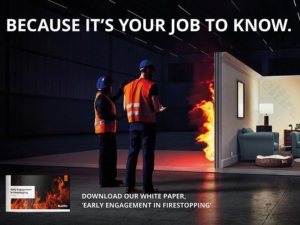
This article explores our new campaign, BECAUSE IT’S YOUR JOB TO KNOW.
Working in an ever-changing industry means staying up to date with regulations, best practice, and new scopes of application. The beauty of the construction industry is that you have the collective power to positively impact future homes, workspaces, and leisure hubs for millions of people across the country.
Yet, its fast-paced nature makes it easy to get left behind. One way to combat this is to consciously adapt to the changing world and be willing to learn and understand the what – what is your role in firestopping? – and the why – why do you need to fulfil it? Why have you made that decision?
While some decisions regarding firestopping may appear trivial and routine, they are, in fact, crucial determinations that can be a matter of life and death.
It is illustrative to see how often, but not always, disaster leads to legislation changes. For instance, the Lakanal House fire brought about the Construction Strategy ‘2025’ in July 2013; the Wharfside fire in 2015 saw the introduction of the Construction Strategy ‘2016-2020’ in March 2016; and the Grenfell Tower fire saw Hackitt’s Independent review in 2017, which led to the Building Safety Act in 2022.
Since the Grenfell Tower fire and the introduction of the Building Safety Act, the importance of passive fire protection has started to be recognised. Though no fire should be overlooked, the tragedy of the Grenfell Tower exposed the decades of deregulation and lack of regard for fire safety across all sectors. This exemplified the incompetence and misconduct within this country’s government and construction industry.
In the past couple of years, the industry has started to embrace cultural change, and many positive changes are taking place. There is more teamwork and collaboration across trades, increased educational resources, and early engagement across projects. But there is still a long way to go.
Our campaign hopes to create an open conversation about embracing responsibility, while nurturing best practice.
Why? BECAUSE IT’S YOUR JOB TO KNOW.
Whose job is it to know?
Passive fire protection is a critical component of fire safety, ensuring the protection of people and property. Take, for example, service penetration sealing, where the effectiveness of the firestop relies on factors such as its design, installation, the substrate it’s installed into, and the actual services installed. Dryliners, mechanical contractors, electricians, and other specialist trades, along with the wall manufacturers, directly influence the efficiency of the whole system. Consequently, all stakeholders involved in the design and installation of service penetration seals are responsible for communicating this information early enough to ensure the building aligns with the tested details available.
What do you need to know?
Understanding your role in firestopping is paramount to ensuring that buildings meet the regulatory requirements. A key aspect of this is understanding compartmentation – the practice of dividing the premise into areas of manageable risk using fire-resistant barriers. Effective compartmentation is not solely about the products used but how they are tested in different applications and installed. A building must be designed and built around tested details, requiring collaboration and early engagement among all stakeholders.
The complexity of service penetration sealing requires understanding your involvement at different RIBA stages and how taking responsibility can facilitate the project’s next stage. At the design stage, this looks like proactively considering the project’s wants and needs, including the fire strategy requirements, such as essential fire ratings and the location of fire-rated walls and floors.
Central to this understanding is competency, built from skills, knowledge, experience, and behaviours. However, recognising your limitations is equally important. This encourages you to seek answers beyond your limitations, reaching out to those competent on the subject matter.
But when – and how?!
Legislation changes drive standards, laws, and sometimes even mindsets. But the industry mustn’t wait for government: the time to act is now.
It is never too late to change the way you work and ensure fire safety is at the forefront of your projects. Though you may feel apprehensive about work completed on previous projects, acknowledging the need for change is the first step towards improvement. Taking proactive steps towards doing the right thing is crucial, as waiting for government will be too late.
Regardless of how competent you think you are or the duration of your study, it is important to refresh your skills and stay up to date with current practices. Engaging in continuous training and seeking opportunities to expand your knowledge is highly recommended. This may involve attending CPDs or product-specific training, participating in early engagement meetings, or examining sample boards as a benchmark for compliant installations. The motivation to improve must come from within yourself.
WHY is it your job to know?
At Quelfire, the question we believe must be encouraged is ‘why?’. The ultimate reason firestopping needs to be compliant is to save lives. Should service penetration seals need to fulfil their purpose in case of a fire outbreak, there should be a high level of confidence they will work as they are supposed to. From a tender perspective, once all parties agree upon and understand the design, the risk is mitigated, providing peace of mind.
Considering service penetration sealing at the early stages will also facilitate work at the installation stage. It allows more time for parties to utilise the support offered by the manufacturer and prepare installation work by training on-site labour and arranging procurement of the correct firestopping products per the design. Compliant installations rely on all parties sharing their areas of expertise.
To ensure buildings are safe and comply with relevant regulations, firestopping needs to be designed according to the manufacturer’s tested details. Suppose firestopping is not considered when decisions are made about the location of compartmentation walls and central routes of M&E services. In that case, there is no guarantee that the manufacturer will have a tested solution. If these discrepancies come to light too late in the project, stakeholders can face extra costs and delays due to needing to redesign service penetrations.

WE TEST…
Because evidence matters. Because it enables us to respond more quickly.
Because offering transparency helps educate our customers.
Because it’s our job to inform best practice.
Because it’s our job to offer guidance. Because firestopping is complex.
Because results are worth sharing.
Because people matter.
WE SHARE…
BECAUSE IT’S YOUR JOB TO KNOW.
Download our White Paper, ‘Early Engagement in Firestopping’ at quelfire.co.uk/campaign
The sooner, the better.
